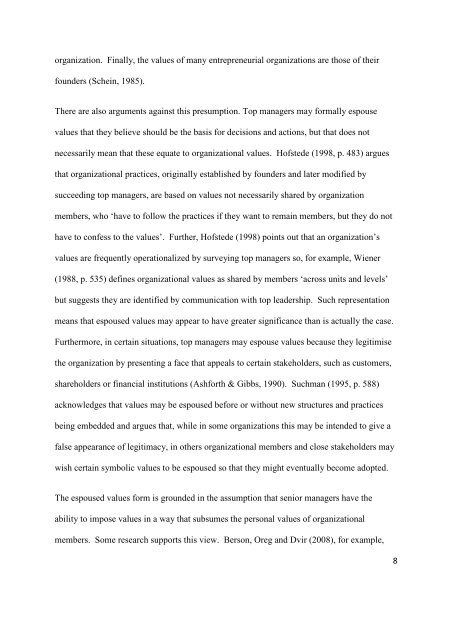Organizational values: A dynamic perspective Abstract Keywords
Organizational values: A dynamic perspective Abstract Keywords
Organizational values: A dynamic perspective Abstract Keywords
Create successful ePaper yourself
Turn your PDF publications into a flip-book with our unique Google optimized e-Paper software.
organization. Finally, the <strong>values</strong> of many entrepreneurial organizations are those of their<br />
founders (Schein, 1985).<br />
There are also arguments against this presumption. Top managers may formally espouse<br />
<strong>values</strong> that they believe should be the basis for decisions and actions, but that does not<br />
necessarily mean that these equate to organizational <strong>values</strong>. Hofstede (1998, p. 483) argues<br />
that organizational practices, originally established by founders and later modified by<br />
succeeding top managers, are based on <strong>values</strong> not necessarily shared by organization<br />
members, who ‘have to follow the practices if they want to remain members, but they do not<br />
have to confess to the <strong>values</strong>’. Further, Hofstede (1998) points out that an organization’s<br />
<strong>values</strong> are frequently operationalized by surveying top managers so, for example, Wiener<br />
(1988, p. 535) defines organizational <strong>values</strong> as shared by members ‘across units and levels’<br />
but suggests they are identified by communication with top leadership. Such representation<br />
means that espoused <strong>values</strong> may appear to have greater significance than is actually the case.<br />
Furthermore, in certain situations, top managers may espouse <strong>values</strong> because they legitimise<br />
the organization by presenting a face that appeals to certain stakeholders, such as customers,<br />
shareholders or financial institutions (Ashforth & Gibbs, 1990). Suchman (1995, p. 588)<br />
acknowledges that <strong>values</strong> may be espoused before or without new structures and practices<br />
being embedded and argues that, while in some organizations this may be intended to give a<br />
false appearance of legitimacy, in others organizational members and close stakeholders may<br />
wish certain symbolic <strong>values</strong> to be espoused so that they might eventually become adopted.<br />
The espoused <strong>values</strong> form is grounded in the assumption that senior managers have the<br />
ability to impose <strong>values</strong> in a way that subsumes the personal <strong>values</strong> of organizational<br />
members. Some research supports this view. Berson, Oreg and Dvir (2008), for example,<br />
8
















